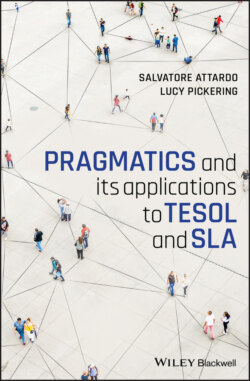Читать книгу Pragmatics and its Applications to TESOL and SLA - Salvatore Attardo - Страница 18
1.1.5 Modularity
ОглавлениеAnother way of arguing about the boundary between semantics and pragmatics is to resort to modularity arguments. As a teacher, you want your student to “think” in the L2; however, to do so they cannot refer to a rule and figure out what to say based on that, nor can they monitor what they say word by word. All those strategies are way too slow to produce fluent output. The learners must rely on automatic processing. Cognitive psychology has introduced the idea of “fast” and “slow” mental processes. In order to understand the difference between fast and slow processing, we must understand modularity.
Modularity is the idea that some mental processes are “encapsulated,” that is, they are based on an input and do not take into consideration anything else. Consider reflexes, for example, blinking when something approaches your eye does not depend on the will of the subject. You cannot will yourself into not blinking. Therefore, we can assume that the blinking reflex is a module, which takes as input the proximity to the eye of an object and is encapsulated, that is, does not consider other inputs, such as the will of the subject not to blink.
Visual illusions are likewise examples of modularity: consider the Müller-Lyer figures in Figure 1.7. Even after you have been told that the two horizontal lines are of the same length, you cannot help seeing them longer and shorter. This tells us the perception of the length of the lines is a module (i.e., is encapsulated), vis-à-vis the knowledge of their length.
Figure 1.7 The Müller-Lyer figures.
Within language, we know that all the meanings of a word get activated when it is first read, albeit for a very short time (about 200 milliseconds, well below the level of consciousness). Later the non-contextually relevant meanings are suppressed, but the activation of the irrelevant meanings cannot be stopped; hence it is a module. While modularity has much to contribute to cognitive science, as a theory of the boundary between semantics and pragmatics, it is a nonstarter (Récanati, 2010, pp. 1–6).
Some theories, for example, Relevance Theory, would see semantics as a code, since it is part of the language system and hence a module, since a code can only consider the information encoded within it. Conversely, pragmatics is the interplay of the semantic code, with contextual information, logical inferences, and pragmatic principles such as Relevance. However, leaving aside Relevance Theory, we know that disambiguation and determining the truth of an utterance rely on pragmatic factors, hence semantics, which deals with disambiguation (i.e., finding the meaning of the sentence) cannot be modular vis-à-vis pragmatics.
Furthermore, even the concepts themselves that are expressed by words are sensitive to context. Consider the word cut: we can define cut as sever, but it is clear that cut in cut the grass is rather different from cut the paper and cut his/her finger: first, in cut the grass and cut the paper, the severing is complete: at the end of the action, the two parts are no longer attached. In the cutting of the finger, we would need to specify that he/she cut his/her finger off, to achieve full severing. Second, in the cutting of the grass, the use of a lawnmower (or a scythe) requires a largely horizontal motion, whereas paper and finger cutting can happen irrespective of their orientation. So there are “sub-concepts,” restricted forms of cutting (completely vs. partially; horizontally vs. omni-directionally). These are called “ad hoc concepts” and are activated by pragmatics (context).
